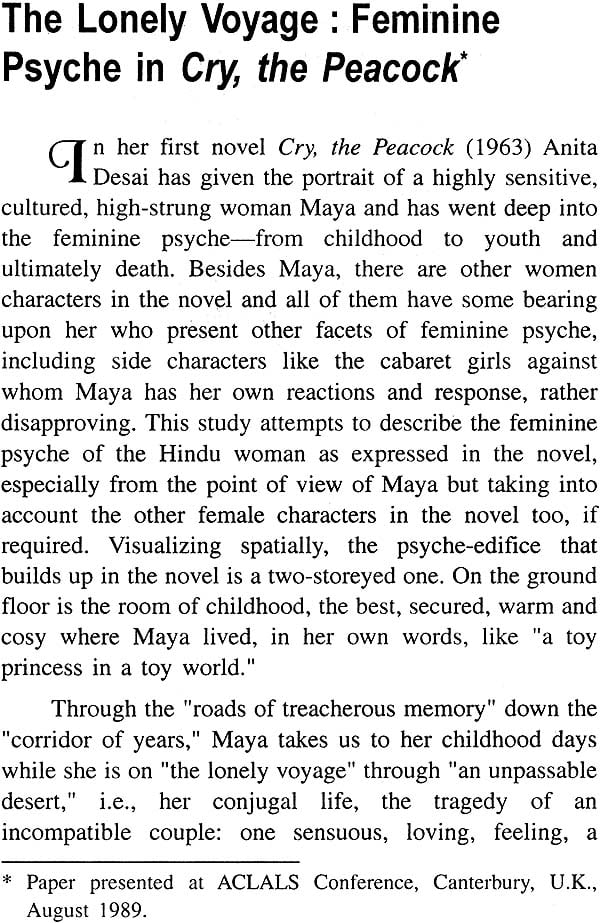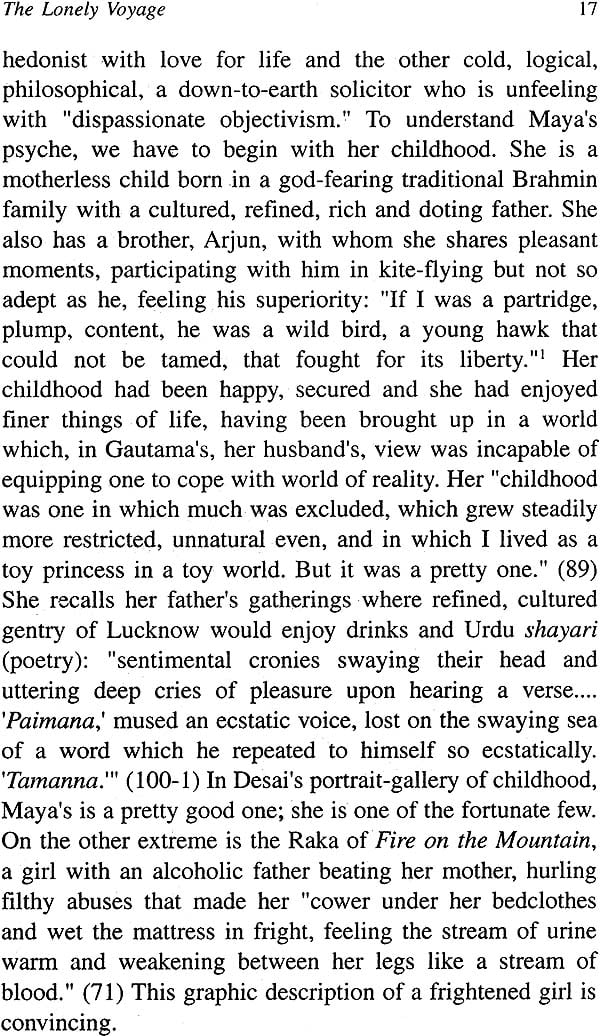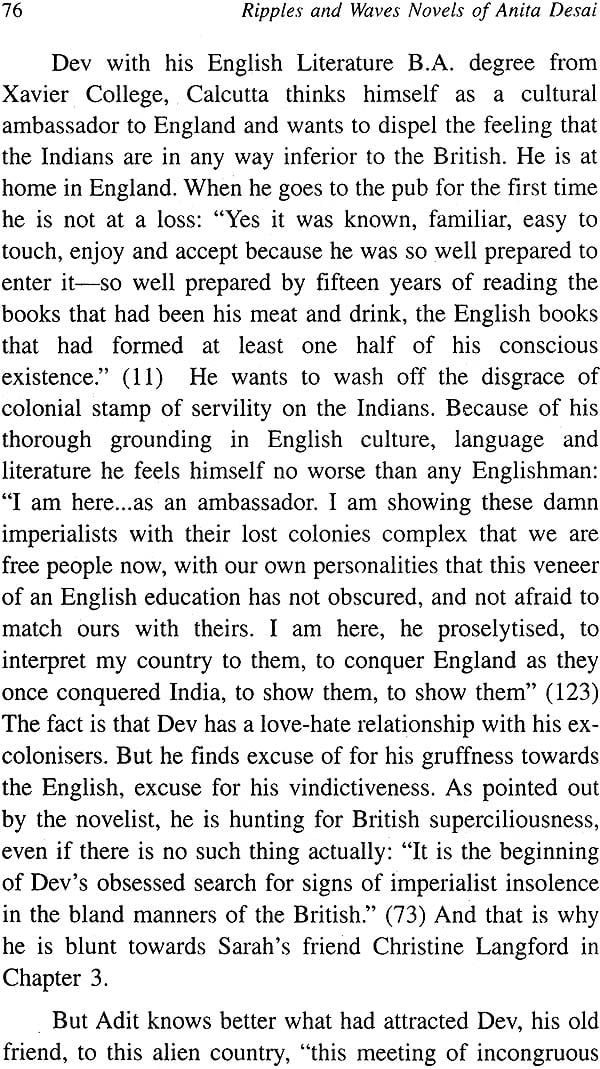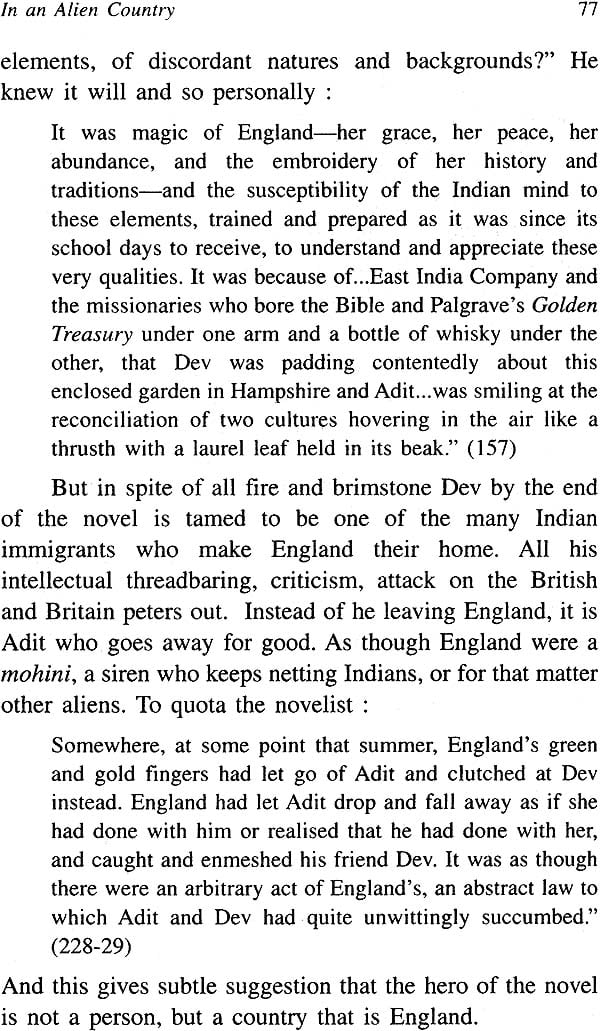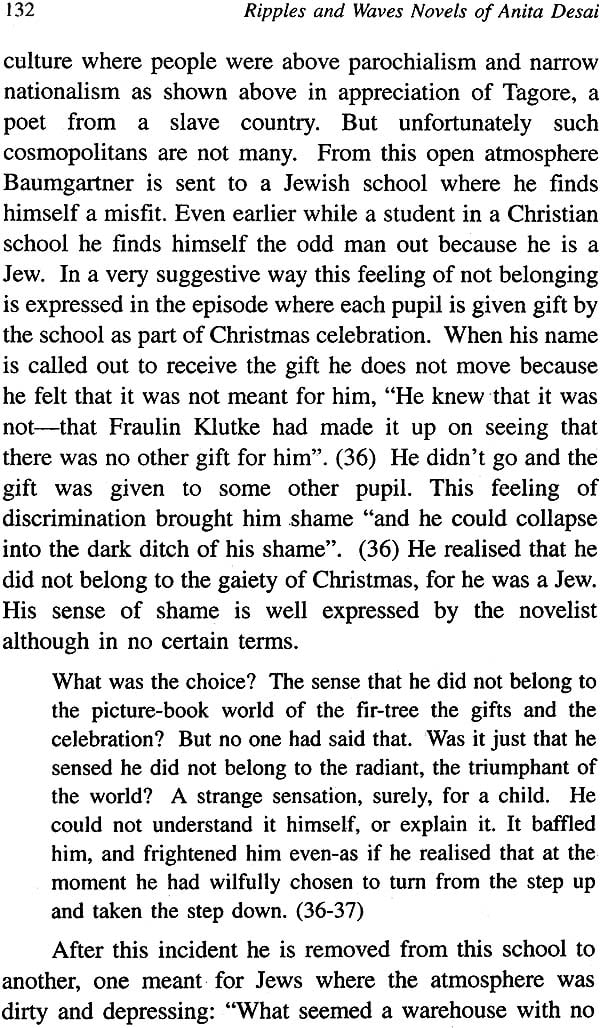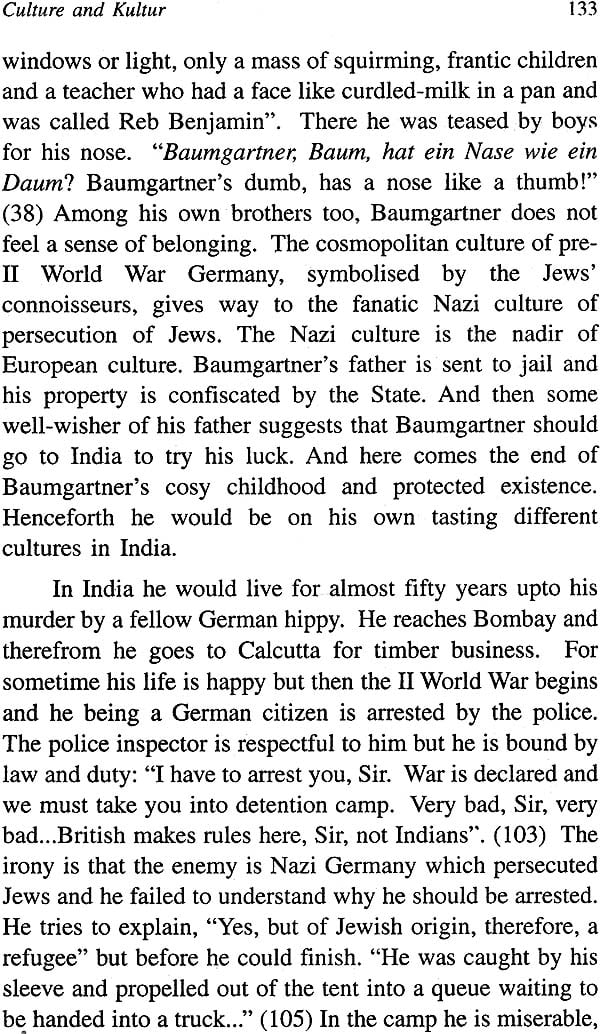
Ripples and Waves Novels of Anita Desai
Book Specification
| Item Code: | NAJ546 |
| Author: | Prabhat Kumar Pandeya |
| Publisher: | Banaras Hindu University |
| Language: | English |
| Edition: | 2007 |
| ISBN: | 818530517X |
| Pages: | 197 |
| Cover: | Hardcover |
| Other Details | 9 inch X 5.5 inch |
| Weight | 310 gm |
Book Description
A study of Anita Desai's novel by a scholar who has worked for sixteen years on her. Each novel is studied from a particular point of view. Many of the chapters were originally papers that were presented 1TI different seminars and conferences held in India and abroad. There is no dearth of books on Desai. However, Ripples and Waves is distinguished by the scholar's insight and religio-cultural analysis of symbols used in the novels. The author provides perceptive analysis of female characters of the novels. The book provides a fresh approach to Desai's novels.
Prabhat Kumar Pandeya (b.1945) had his higher education at Banaras Hindu University. He obtained Ph.D. degree on tales of Nathaniel Hawthorne. But he has supervised Ph.D. research in British and Indian Literature in English too. A creative writer and translator, he has translated books, poems, stories from Hindi into English and vice-versa. In 1995 he was the only representative from India at III Language International, Conference, Ellsinore, Denmark where he chaired a session on literary translation. He has translated four books and Hanumanchalisa in verse. His Vishnu: The Blue God is the latest publication.
This book is the outcome of my sixteen years l!J involvement with Anita Desai during which I supervised two theses officially and two unofficially on her. In 1989 my paper "The Lonely Voyage: Feminine Psyche in Cry, the Peacock" was accepted for ACLALS (Association for Commonwealth Language and Literature Studies) Conference to be held at Kent University, Canterbury, U.K. I presented my paper and received good response. Before this I was not interested in Indian Literature in English. My U.K. experience made me realise that as an Indian my work on Indian Literature in English will be more authentic than my work on British or American literature. Since then I have been presenting papers on Anita Desai for different conferences and seminars in India. Some of my papers were accepted for seminars abroad also but for want of fund I could not go. Some papers were written for journals or books. Since these papers were written for different seminars therefore the book does not have a thematic centre as is usual in a book or a thesis published in book form. The common thread that runs through all the essays is the novelist. There are two essays each on Cry, the Peacock, Baumgartner's Bombay and Bye-Bye Blackbird for the simple reason that they were written for different seminars. When my University accepted my proposal for publication I gathered all essays. First I thought to publish all available papers but my former colleague and friend Prof. A. K. Tripathy, now Professor of English, Sanaa University, Yemen, asked me to write an introduction. The idea appeared sensible and I followed it. I realize that all essays may not be of same quality but whatever be I thought bringing out these essays published in different journals and books in a book would prove useful to Desai scholars. There is no dearth of books on Desai but then every scholar has his own perspective, capability, and understanding. It is like Wall ace Stevens' "Thirteen Ways to Look at Blackbird". My claim to originality is my perspective. Modestly I can say that I have tried to interpret certain symbols and ideas in the light of Hindu religion and culture. The peacock symbol in Cry, the Peacock caused much trouble in that according to the novelist the peacock's numerous eyes on its feathers are eyes of wisdom. I contacted my colleague Dr. M. N. Tiwari of Department of History of Art and he came to my rescue by giving me citation from a paper on J ain iconography. The path of scholarship is never easy. More often than not it is sweat and tears but once one is able to go through one realizes the love's labour won.
I cannot be the judge of my own work. Let its quality be judged by the scholars. I'd be too happy and thankful to receive comments and criticism from them. All that I can say is that I put my best and hope that my modest effort would prove useful to Anita Desai scholars. And I do feel a sense of fulfilment now that the book is coming out by courtesy of Banaras Hindu University which not only awarded me B.A., M.A., Ph.D. degrees but also employed me as Lecturer in 1973. Since then I am teaching there.
I acknowledge my thanks to the journals and editors of books where some of these essays were published. My thanks to Publication Committee of Banaras Hindu University and Dr. Vishwanath Pandey, O.S.D. Publication and P.R.O. Thanks to Prof. A. K. Tripathy for his useful suggestion. I am sure he'd be happy to see the book. Thanking one's wife sounds hollow, yet I cannot ignore Maya's role in all my academic achievements. Many a time she helped me understand the mysteries of feminine psyche. She always encouraged me and bore with my temper and erratic life style. Wife is the home-maker and if there is no home how can one accomplish anything.
Anita Desai (b.1937) is an important novelist of ","post-Independence Indian literature in English. There are other contemporary women writers like Nayantara Sehgal, Jhabwala, Kamala Markandeya etc. but her place in unique in the sense that her focus is on the inner reality of her protagonists. Unlike Nayantara, she is not much concerned with socio-political reality, although it is found in some of her novels. To use Hopkins's expression, Desai is concerned with the "inscape" of her heroines. She is born of German and Bengali parents and thus inherits two traditions. She uses her German background in Baumgartner's Bombay. She has keen observation and grasp over Indian reality and she makes effective use of it. In Voices in the City she has given realistic description of middle-class Bengali joint family. She prefers not to say much about herself, yet through her interviews given from time to time we have some idea about her works, her preferred characters and influences on her writing.
She is basically a domestic novelist in the sense that her novels are family centric. Almost all her novels move around family and familial relationships. Being a woman it is but natural, for women can make or mar home. But all women protagonists of Desai are not ideal women and wives or mothers. Many of them do not fit in the stereotype female models given by society. And the reason is that Desai is not interested in the conformists. She is more interested in the Naysayers. In one of her interviews she said:
I am interested in characters who are not average but have retreated, or have been driven into some extremity of despair and to turn against the general current. It is easy to flow with the current, it makes no demand, it costs no effort, but those who cannot follow it, whose heart cries out 'the great No' who fight the current and struggle against it, they know what the demands are and what it costs to meet them.
This idea is reinforced by Desai when she quotes her favourite Greek poet Cavafy twice in Where Shall We Go This Summer? :
To certain people there comes a day when they must say the great Yes or the great No. He who has the yes ready within him reveals himself at once, and saying it he crosses over to the path of honour and his own conviction. He who refuses does not repent. Should he be asked again, he would say No again. And yet that No-the right No-crushes him for the rest of his life.
Desai's choice of Cavafy is not accidental but deliberate, for there seem to be some similarities. Constantine Cavafy (1863-1933) is the pseudonym of Alexandria born Konstantines Petrou Kavafis who called himself a "poet of old age", for his most important poetry was written after his 40th year. He is well known to English readers from the many references to his work in Lawrence Durrell's Alexandria Quartet. He himself was a non- conformist, a skeptic who denied or ridiculed traditional Christian values, patriotism, and heterosexuality. When we think of the above lines some Desai characters flash in our mind like Nirode, Sita, Monisha, Laila etc. Existentialism which was so much in the air among the intellectuals of the 1960s goes well with Cavafy's idea. In this respect he is similar to Herman Melville's Naysayers like Bartleby of "Bartleby the Scribener: A Story of Wall Street". There are people who question and protest against the stereotypes. They are with Amy Lowell who in "Patterns" asks "Christ! What are patterns for?" But they have to pay heavily for it. Some succumb to it like Monisha who committed suicide and some like Nirode have to compromise. Of several Naysayers of Desai Nirode is the best example who denies everything, society, family, traditional values.
If there are Naysayers in Desai novels, so are the conformists who are happy fitting in the slot provided by society. These normal characters do not question, they just lead usual ordinary life. We have such characters in almost all her novels. Some examples are Pom in Cry, the Peacock, Monisha's in-laws in Voices in the City Raman in Where Shall We Go This Summer?, Kanti Seth's family in Baumgartner's Bombay, Sarla in In Custody, the Mishra girls in Clear Light of Day, etc. But the Naysayers look down upon such colourless, faceless people. Sita has contempt for them: "They are nothing-nothing but appetite and sex. Only food, sex and money matter. Animals. Man living on animal plane as expressed by T.S. Eliot in "Fragment of an Agon":
Birth, and copulation and death.
That's all, that's all, that's all, that's all.
Birth, and copulation and death,
| Preface | v-vii | |
| 1 | Introduction | 1-15 |
| 2 | The Lonely Voyage : Feminine Psyche in Cry, the Peacock | 16-32 |
| 3 | The Poly-timbred Voice : Women in Cry, the Peacock | 33-45 |
| 4 | Anatomy of Anger : A Study of Voices in the City | 46-57 |
| 5 | The Immigrant Experience in Bye-Bye Blackbird | 58-70 |
| 6 | In an Alien Country : Cross-cultural Experience in Bye-Bye Blackbird | 71-81 |
| 7 | Where Shall We Go This Summer? : A Parturition Drama | 82-87 |
| 8 | To Be Born Female : A Study of Fire on the Mountain | 88-94 |
| 9 | Clear Light of Day : The Das Saga | 95-110 |
| 10 | Linguistic Regionalism : A Study of In Custody | 111-118 |
| 11 | Habibullah, Hyder Ali, and Nur The Muslim Community in some Novels of Anita Desai | 119-129 |
| 12 | Culture and Kultur : A Reading of Banumgartner's Bombay | 130-137 |
| 13 | Social Tyranny and the Individual : Baumgartner's Bombay | 138-144 |
| 14 | Journey to Ithaca : A Polycultural Voyage | 145-152 |
| 15 | The Discriminated Sex : A Study of Fasting, Feasting | 153-159 |
| 16 | Fictional Technique of Anita Desai | 160-173 |
| 17 | The Zigzag Way | 174-187 |
| 18 | Index | 189-191 |
